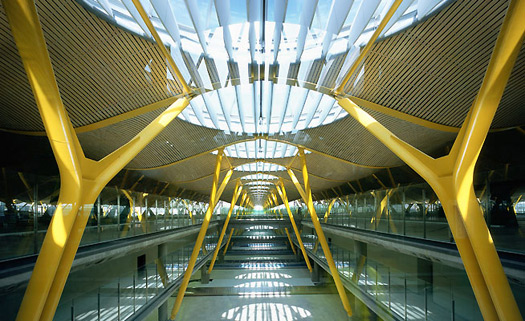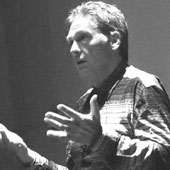 The Madrid-Barajas Airport
The Madrid-Barajas Airport
Some of you may know Oliver Sacks' book The Man Who Mistook His Wife for A Hat. It's about people afflicted with fantastic perceptual and intellectual aberrations, and in particular a man who looks at something familiar — his wife — but perceives something completely different.
Well, I’ve become one of those people.
It happened to me most recently at Madrid’s new airport. One minute I was admiring Richard Rogers’s gorgeous roof, and the play of light upon curves. But I suddenly stopped perceiving these effects as aesthetic. In place of elegant forms and vistas, I started to contemplate the vast amount of energy embodied in the artifacts, structures and processes that surrounded me.
A big new airbus, taxiing in to park, made me wonder how many thousands, millions, of pounds of matter and energy must have been used to build it. Beside me was an elegant concrete pillar. It looked benignly tree-like with a gently curving trunk and branches, higher up, that supported a soaring roof. But how many carbon dioxide emissions were generated during its fabrication? A ton of CO2 is emitted for every ton of concrete that ends up in a pillar, or the miles of concrete apron that stretched, in every direction in Madrid. Millions of tons of concrete visible to the eye. Millions of tons of emissions out of sight.
Then there was the noise. I don’t usually notice the background hiss and hum of these great modern spaces. But this time my cognitive filters seemed to fail. I became aware of an ambient, angst-inducing roar. All that air-conditioning, cooling huge volumes of empty space, blowing gales of out hot air to goodness knows where in the sky. Eight per cent of the world's total electricity supply is used to cool buildings in the United States.
Then there was the light. There was a bank of large plasma screens. On the screens, ads were playing. But all I could think about was their greed for electricity. Did you know that flat screens use five times more power than the bulbous ones they replaced? And that’s just the power they use. Cathode ray televisions contained mostly air. These new plasma screens are packed densely with complex materials whose manufacture is highly energy intensive.
So I’m the man who mistook a concrete pillar for a threat to the world. But do you know what? I reckon my cognitive confusion in Madrid had just cause. I read a text by Rafael Buitrago about our aesthetic and visceral responses to landscape. The ways we respond aesthetically to our environment, Buitrago argues, may be derived from psychology that evolved to help hunter-gatherers make better decisions: when to move, where to settle, to chase or not to chase, in varying situations. Environmental stimuli as diverse as flowers, sunsets, clouds, thunder, snakes, and predators, activate response systems of ancient origin.
I’m a frequent flyer, not a hunter gatherer. But I’m sure now that feeling the creeps in Madrid was some residual survival instinct being triggered. Not by an inherited fear of snakes, but by a learned fear of degradation to the biosphere and the threat it poses to us all. Many climate change activists complain that "climate pornography” — the promotion of apocalyptic climate change scenarios — is counter-productive. Climate porn, for one British think tank, “offers a thrilling spectacle, but ultimately distances people from the problem." These critics are right. To do things differently, we have to perceive things differently, but not be immobilised by fear, or guilt. We need to be startled out of our complacency, but in such a way that we feel motivated to take meaningful action.
A lot of people seem to have started. Paul Hawken reckons that over one million organizations, populated by 100 million people, are engaged in grass roots activity designed to address climate and other environmental issues. This worldwide movement of movements flies under the radar, he believes, but "collectively, this constitutes the single biggest movement on earth.”
These one million grass roots organisations are just one part of the story. Many big organisations, too, are re-thinking fundamental principles of their business. For many multinationals, the consequences of climate change for the very existence of their business has moved from the realm of “future scenario” to be a real and present danger.
Let me give you some examples I’ve heard about just during the last month: I heard about a top five logistics and parcel delivery company for whose CEO, sustainability is the key driver of the company’s future. I was told that one of the world’s largest shipping ports has decided it must render its operations carbon neutral within a decade. How, I have no idea. But it sounds as if they are completely serious. A major European airport, I learned, is studying how it might feasibly prosper if air travel ceased to be an important part of its business.
Whole countries are getting serious about massive transformational change. Sweden, for example, has made it national objective to be independent of oil within a decade. Switzerland has set a target of becoming a "2000-Watt society." That’s one third of the 6000-Watts of energy consumed by each of its citizens today on food, goods, heating and cooling buildings, mobility and so on. The most dramatic shift, for me, is emerging in Britain — until now, a byword for of wasteful consumerism. The recent publication of the Stern Review Of Climate Change Economics, by a former World Bank chief economist, marks a change in government responses.
It’s not just that Stern's conclusions correspond broadly to what environmentalists have been saying for fifteen years. The fact that the report was commissioned by The Treasury, which controls the nation’s taxation and money, is also key. Money is at stake: something must be done. Stern paves the way for so-called “external” costs to be counted properly for the first time. (Notoriously, economists describe as”external” costs things like energy, water, minerals, the biosphere as a whole, that, until now, have not been properly counted as part of the game. We used energy to exploit resources — but did not pay the full price of the energy or the resources). A government can use fiscal measures to make these so-called “external” costs internal costs, payable by the producer. Matter and energy flowing through the economic system will have to be paid for at full price, rather than taken for granted as a freebie. The Stern review provides an economic justification for dramatic changes to the ways we live.
There’s a truly gigantic design opportunity here. We have to re-design the structures, institutions and processes that drive the economy along. We have to transform material, energy and resource flows that, unchecked, will finish us. In this new design space, the boundaries between infrastructure, content, equipment, software, products, services, space, and place, are blurred. Compared to physical products, or buildings, sustainable services and infrastructures are immaterial. They are adaptive in time and space.
So it’s a huge opportunity, but a new kind of design practice is needed to exploit it. First, this new design practice is more about discovery than blue sky invention. Many of the answers we need already exist. We need to become global hunter-gatherers of models, processes, and ways of living that have been learned by other societies over time. We have to find those examples. Adapt them. Recombine them. Just as biomimicry learns from millions of years of natural evolution, we can adapt the social innovation of other times and places to our present, ultra-modern needs. For example, a lot of people already know how to live more lightly than we do. Hundreds of millions of poor people practise advanced resource efficiency every day of their lives. That’s because they are too poor to waste resources like we rich folk do. Design schools should relocate en masse to favelas and slums. These informal economies are sites of intense social and business innovation.
A second key feature of the new design practise: it is less about control, more about the devolution of power. A good test is whether a design proposal will enable people to retain control over their own territory and resources.
A third feature of the new design practice: it does not have to think big, or act big, to be effective. On the contrary: we have learned about the behaviour of complex systems that small is not small. Small design actions can have big consequences, and these can be positive. If someone builds a bus stop, in an urban slum, a vibrant community can sprout and grow around it. Such is the power of small interventions into complex urban situations. Read Small Change by Nabeel Hamdi for more inspiring examples of the power of designing small.
Item four: The new design practise looks for ways to replace physical resources with information. The information part is knowing where to find something you need to use. If you can locate a thing, and access it easily, you don't have to own it. Think of cars. Most of them are used less than 5% of the time. It’s nonsense. Six hundred cities now have car sharing schemes. The same goes for buildings. In a light and sustainable economy we will share resources, such as time, skill, software, spaces or food, through networked communications.
We don’t have to design sharing systems from scratch. Many already exist. Local systems of barter and non-monetary exchange, such as Jogjami, have existed in India for at least 500 years. A cooperative distribution system called Angadia, or "many little fingers," enables people to send goods over sometimes vast distances without paying. They just need to be internet enabled.
The fifth and hardest aspect to master the new design practice is whole systems thinking. The best example I heard recently is from an entrepreneur called Paul Polak, who helps people in developing countries create more effective water distribution systems. Paul reckons the design and technology of a device, such as a pump, or sprinkler system, is not much more than ten percent of the complete solution. The other ninety percent involves distribution, training, maintenance and service arrangements, partnership and business models. These, too, have to be co-designed.
I began this morning by describing the curious perceptual delusions that I experienced, whilst staring at a concrete pillar in Madrid Airport. I may be nuts, I said, but could there be method in my madness? The ability to perceiving disorders in the environment has helped a lot of creatures survive.
Besides, millions of people seem to share my unease. I suspect there are quite a lot of you in this room. Big companies, and governments, are also readying themselves for transformational change. I promise you that strange bedfellows will be teaming up in the near future. Eugenio Barba calls this “the dance of the big and the small.”
I don’t mind if you choose to dance. I’d be satisfied if, just once this week, you slap a concrete pillar and start to wonder.
John Thackara originally delivered this essay as a lecture at the Global Place Conference in Ann Arbor, Michigan, January 5, 2007.

